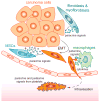Epithelial-Mesenchymal Plasticity: A Central Regulator of Cancer Progression
- PMID: 26437589
- PMCID: PMC4628843
- DOI: 10.1016/j.tcb.2015.07.012
Epithelial-Mesenchymal Plasticity: A Central Regulator of Cancer Progression
Abstract
The epithelial-mesenchymal transition (EMT) program has emerged as a central driver of tumor malignancy. Moreover, the recently uncovered link between passage through an EMT and acquisition of stem-like properties indicates that activation of the EMT programs serves as a major mechanism for generating cancer stem cells (CSCs); that is, a subpopulation of cancer cells that are responsible for initiating and propagating the disease. In this review, we summarize the evidence supporting the widespread involvement of the EMT program in tumor pathogenesis and attempt to rationalize the connection between the EMT program and acquisition of stem cell traits. We propose that epithelial-mesenchymal plasticity is likely controlled by multiple varients of the core EMT program, and foresee the need to resolve the various programs and the molecular mechanisms that underlie them.
Keywords: EMT (epithelial–mesenchymal transition); cancer stem cells; plasticity; tumor progression.
Copyright © 2015 Elsevier Ltd. All rights reserved.
Figures
References
-
- Akalay I, Janji B, Hasmim M, Noman MZ, Andre F, De Cremoux P, Bertheau P, Badoual C, Vielh P, Larsen AK, et al. Epithelial-to-mesenchymal transition and autophagy induction in breast carcinoma promote escape from T-cell-mediated lysis. Cancer Res. 2013;73:2418–2427. - PubMed
-
- Akalay I, Tan TZ, Kumar P, Janji B, Mami-Chouaib F, Charpy C, Vielh P, Larsen AK, Thiery JP, Sabbah M, et al. Targeting WNT1-inducible signaling pathway protein 2 alters human breast cancer cell susceptibility to specific lysis through regulation of KLF-4 and miR-7 expression. Oncogene. 2015;34:2261–2271. - PubMed
-
- Aleskandarany MA, Negm OH, Green AR, Ahmed MA, Nolan CC, Tighe PJ, Ellis IO, Rakha EA. Epithelial mesenchymal transition in early invasive breast cancer: an immunohistochemical and reverse phase protein array study. Breast Cancer Res Treat. 2014;145:339–348. - PubMed
Publication types
MeSH terms
Grants and funding
LinkOut - more resources
Full Text Sources
Other Literature Sources


